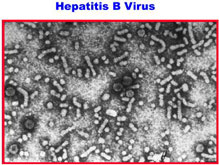Hepatitis C is now declared curable. Hepatitis B is still not, despite having been discovered nearly 50 years ago. An interview with Dr. Timothy Block of the Hepatitis B Foundation and the Baruch S. Blumberg Institute. The future does look bright…
Perhaps this should not be a surprise, thinks Timothy Block, PhD, president and co-founder of the Hepatitis B Foundation (HBF) and its research arm, the Baruch S. Blumberg Institute. According to Block,there are two main reasons for the “cure deficit” between hepatitis B and C — funding and physiology.
He points out that commercial and federal investment in hepatitis C have been far greater than in hepatitis B. And that has clearly paid off in terms of finding a hepatitis C cure. “You get what you pay for,” he observes.
Physiologically, hepatitis B also presents unique challenges not found with hepatitis C — most notably cccDNA (or covalently closed circular DNA), the “mini- chromosome” produced by the hepatitis B virus. The cccDNA persists in the nucleus of the liver cell, where it can hide amidst the host’s own chromosomes, apparently out of reach of the cell’s own defense systems.
Acting like “an indestructible template,” cccDNA continues to produce virus particles throughout the life of the infected liver cell, even in people being treated with antiviral agents.
Hepatitis C, on the other hand, doesn’t enter the cell’s nucleus, so it’s possible to cure a person by stopping this virus from replicating long enough for the liver cells to regenerate.
But remember that people who have been “cured” of hepatitis C can still get re-infected,” Block cautions. The hepatitis C drugs apparently do not trigger an immune response that protects against re-infection.
In contrast, some people can be cured of hepatitis B, either naturally or through drug therapy. These individuals do seem to have long-term protective immunity. “And that’s what we are aiming for,” he declares.
Why We Need a Cure for Hepatitis B
It can be argued that the approved antiviral agents are very successful in keeping the virus under control. So do we really need a cure? Definitely yes, Block replies emphatically.
Current antiviral drugs are effective, but need to be taken lifelong and are recommended for use in only about half of the infected population. And even after 10 years of use, the antivirals reduce HBV-related diseases by only about 50 to 60 percent. The drugs can also lead to the development of resistant hepatitis B strains (drug resistance).
For those who benefit from treatment, the antiviral drugs have been transformational and prove that medical intervention can be effective. However, there are millions who do not benefit and are still left vulnerable.
Clearly, new approaches to a “functional cure” are needed, which Block defines as “returning the risk of death due to hepatitis B to the level of someone who has a resolved infection.” And the person should not need to take any drugs to stay at this low-risk level.
Targeted Strategy for a Cure
The HBF/Blumberg Institute scientists, with their research partners from Drexel University College of Medicine, both located in the HBF’s Pennsylvania Biotechnology Center, are developing two types of therapies: direct-acting antivirals and innate host defense activators. The first type inhibits virus-host interactions and viral gene products; the second recruits the host’s immune system to attack and eliminate cccDNA and infected liver cells.
For each of these approaches, the researchers have identified key steps to target in the hepatitis B infection cycle, from virus entry into the liver cell, to cccDNA replication, to formation of virus particles.
For many of these steps, “Our scientists have developed assays that can be used to screen for new drugs. We are a recognized leader in designing and developing these assays and, for a time, had the only cccDNA- dependent cell lines,” notes Block. Almost 100 different cell lines for assays have been developed that can be used to screen for drugs that activate the innate host defense pathways.
For drug screening, cell lines are incubated with potential drug candidates to try and find new therapeutic drugs for future hepatitis B treatment. The strategic goal is to discover new drugs that complement existing therapies, but also enable the immune system to provide long-lasting antiviral protection, even when the person is no longer on drug therapy.
The strategic goal is to discover new drugs that complement existing therapies, but also enable the immune system to provide long-lasting antiviral protection, even when the person is no longer on drug therapy.
Several compounds in development already show some effectiveness in animal models. “We have a capsid inhibitor, a pregenomic RNA capsid inhibitor (JT Guo), an HBsAg inhibitor (A Cuconati), a cccDNA repressor (H Guo, A Cuconati, JT Guo), and an activator of innate host defense pathways (J Chang and JT Guo),” Block reports.
He is particularly excited about their stimulator of interferon genes (STING) agonist, which was very effective in mouse models. The research group is now working on a human STING agonist, although an appropriate assay for this compound still needs to be developed.
What the Future Holds
“The Hepatitis B Foundation and its Blumberg Institute have contributed
to some of the most important work in studying the phases of the virus lifecycle that has led to the currently available drugs. Our researchers continue to be at the forefront in developing a promising pipeline for hepatitis B drug discovery,” says Block.
“I am absolutely confident that a cure is possible” he asserts. “After all, enough people with hepatitis B resolve their infections, either medically or spontaneously — even some people with chronic infections. So we know it’s possible.”







